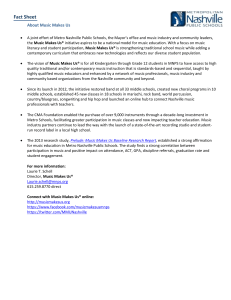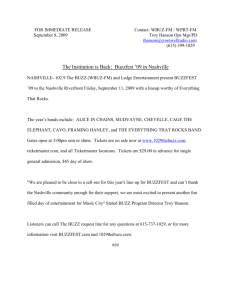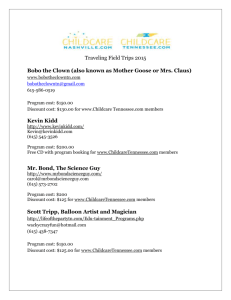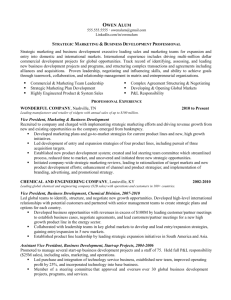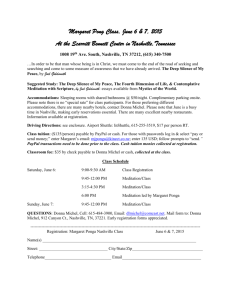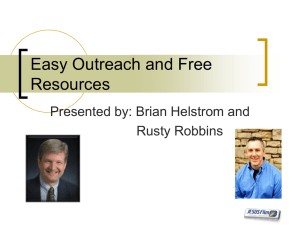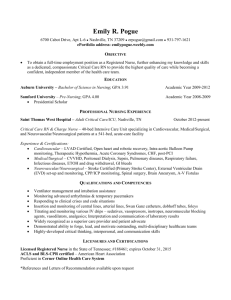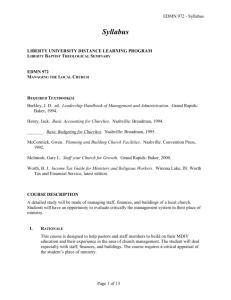NORTH GREENVILLE UNIVERSITY Graduate School of Christian
advertisement
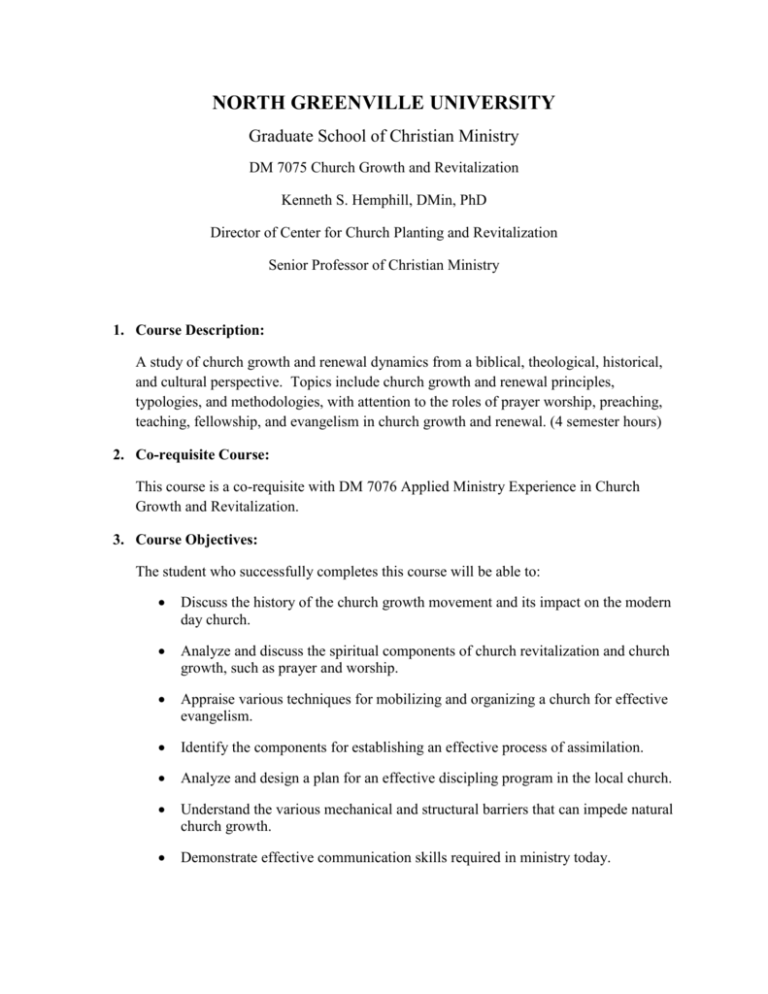
NORTH GREENVILLE UNIVERSITY Graduate School of Christian Ministry DM 7075 Church Growth and Revitalization Kenneth S. Hemphill, DMin, PhD Director of Center for Church Planting and Revitalization Senior Professor of Christian Ministry 1. Course Description: A study of church growth and renewal dynamics from a biblical, theological, historical, and cultural perspective. Topics include church growth and renewal principles, typologies, and methodologies, with attention to the roles of prayer worship, preaching, teaching, fellowship, and evangelism in church growth and renewal. (4 semester hours) 2. Co-requisite Course: This course is a co-requisite with DM 7076 Applied Ministry Experience in Church Growth and Revitalization. 3. Course Objectives: The student who successfully completes this course will be able to: Discuss the history of the church growth movement and its impact on the modern day church. Analyze and discuss the spiritual components of church revitalization and church growth, such as prayer and worship. Appraise various techniques for mobilizing and organizing a church for effective evangelism. Identify the components for establishing an effective process of assimilation. Analyze and design a plan for an effective discipling program in the local church. Understand the various mechanical and structural barriers that can impede natural church growth. Demonstrate effective communication skills required in ministry today. 4. Course Texts Required Texts: All students must read the required books. Rainer, Thom S. The Book of Church Growth: History, Theology, and Principles. Nashville: Broadman, 1993. Hemphill, Ken. The Antioch Effect. Nashville: Broadman and Holman, 1994. McNeal, Reggie. Missional Renaissance: Changing the Scorecard for the Church. Jossey-Bass Leadership Network Series, 2009. Additional Reading: Students should complete a total of 2,000 pages of reading, including the three required texts, by the beginning of the seminar. This total should include at least one text from each of the following categories. Read at Least One of the Following: Historical: Arn, Win, Elmer Towns, and Peter Wagner. Church Growth: State of the Art. Wheaton: Tyndale, 1989. Barna, George. Successful Churches: What They Have in Common. Glendale, CA: Barna Research, 1990. Hadaway, C. Kirk. Church Growth Principles: Separating Fact from Fiction. Nashville: Broadman, 1991. McGavran, Donald A. Back to Basics in Church Growth. Wheaton: Tyndale, 1989. McGavran, Donald A. and George G. Hunter. Church Growth Strategies that Work. Nashville: Abingdon, 1980. Miles, Delos. Church Growth: A Mighty River. Nashville: Broadman, 1981. Towns, Elmer L., John N. Vaughan, and David J. Seifert. The Complete Book of Church Growth. Wheaton: Tyndale, 1981. Wagner, C. Peter. Church Growth and the Whole Gospel: A Biblical Mandate. San Francisco: Harper and Row, 1981. Read at Least Two of the Following: Spiritual Blue, Lloyd C. Expository Preaching for Church Growth. Dallas: E.K. Bailey Ministries, 1998. Eby, David. Power Preaching for Church Growth. Great Britain: Mentor, 1996. Freud, Howard, Jr. Renewing the Sacred Center: Church Revival from the Inside Out. Valley Forge, PA: Judson, 1998. Frizzell, Gregory R. and Henry T. Blackaby. Biblical Patterns for Powerful Church Prayer Meetings. Master Design, 2000. Hemphill, Ken. EKG: The Heartbeat of God. Nashville: Broadman, 2004. Hemphill, Ken. Eternal Impact: The Passion of Kingdom Centered Communities. Nashville: Broadman, Kelley, Dean M. Why Conservative Churches are Growing. Reprint. Macon, GA: Mercer University Press, 1986. Laney, J. Carl. A Guide to Church Discipline. Minneapolis: Bethany House, 1985. McIntosh, Gary L. Biblical Church Growth: How You Can Work With God to Build a Faithful Church. Grand Rapids: Baker, 2003. Morgenthaler, Sally. Worship Evangelism: Inviting Unbelievers into the Presence of God. Grand Rapids: Zondervan, 1995. Read at Least One of the Following: Revitalization Baker, R. D. Reviving the Plateaued Church. Nashville: Convention. 1991. Barna, George, Turn Around Churches. Ventura, CA: Regal, 1993. Buttry, Daniel. Bringing Your Church Back to Life: Beyond Survival Mentality. Valley Forge, PA: Judson, 1988. Crandall, Randall K. Turn Around Strategies for the Small Church. Nashville: Abingdon, 1995. Frazee, Randy. The Come Back Congregation: New Life for a Troubled Ministry. Nashville: Abingdon, 1995. Hemphill, Ken. Revitalizing the Sunday Morning Dinosaur. Nashville: Broadman and Holman, 1996. McCutcheon, Mike. Rebuilding God’s People: Strategies for Revitalizing Declining Churches. Camp Hill, PA: Christian Publications, 1993. McLaren, Brian. Reinventing the Church. Grand Rapids: Zondervan, 1998. Ott, E. Stanley ed. Twelve Dynamic Shifts for Transforming Your Church. Grand Rapids: Eerdmans, 2002. Schaller, Lyle E. 44 Steps Up Off the Plateau. Nashville: Abingdon, 1993. Stetzer, Ed and David Putman. Breaking the Missional Code. Nashville: Broadman and Holman, 2006. Read at Least One of the Following: Evangelism Atkinson, Donald A., and Charles L. Roesel. Meeting Needs, Sharing Christ: Ministry Evangelism in Today’s New Testament Church. Nashville: LifeWay, 1995. Beougher, Sharon, and Mary Dorsett. Women and Evangelism: An Evangelistic Lifestyle from a Woman’s Perspective. Wheaton, Billy Graham Center, 1994. Beougher, Timothy and Alvin Reid, eds. Evangelism for a Changing World. Wheaton: Harold Shaw, 1995. Coleman, Robert E. The Master Plan of Evangelism. Westwood: Revell, 1978. Drummond, Lewis A. and Calvin Miller. Reaching Generation Next: Effective Evangelism in Today’s Culture. Grand Rapids: Baker Books, 2002. Hamilton, Adam and Lyle E. Schaller. Leading Beyond the Walls: Developing Congregations With a Heart for the Unchurched. Nashville: Abingdon, 2002. Hemphill, Ken and Paula. Splash: Show People Love and Share Him. Tigerville, SC: Auxano Press, 2007. Hunter, George G. III. The Celtic Way of Evangelism. Nashville: Abingdon, 2000. Miles, Delos. Evangelism and Social Involvement. Nashville: Broadman Press, 1986. Read At Least One of the Following: Assimilation Brown, Truman and James E. Hightower, comp. After They Join: 10 Ways to Assimilate New Members. Nashville: Convention Press, 1994. Galloway, Dale E. The Small Group Book: The Practical Guide for Nurturing Christians and Building Churches. Grand Rapids: Revell, 1995. Hemphill, Ken and Mike James. V.E.L.C.R.O. Church. Tigerville, SC: Auxano Press, 2011. Hendricks, William D. Exit Interviews: Revealing Stories of Why People are Leaving the Church. Chicago: Moody, 1993. Schaller, Lyle E. Assimilating New Members. Nashville: Abingdon, 1978. Searcy, Nelson. Fusion. Ventura, CA: Regal, 2007. Stutzman, Ervin R. Welcome! A Biblical and Practical Guide to Welcoming New Members. Scottdale, PA: Herald Press, 1990. Read At Least One of the Following: Discipleship/Teaching Arn, Win. The Master’s Plan for Making Disciples. Grand Rapids: Baker Books, 1998. Coleman, Robert et al, eds. Disciple Making: Training Leaders to Make Disciples. Wheaton: Billy Graham Center, 1994. Hanks, Billie, and William A. Shell, eds. Discipleship: Great Insights from the Most Experienced Disciple Makers. Paternoster Press, 1993. Hull, Bill. The Disciple-Making Church. Grand Rapids: Revell, 1998. Moore, Waylon B. Multiplying Disciples: The New Testament Method for Church Growth. Tampa, FL: Missions Unlimited, 1981. Read At Least One of the Following: Miscellaneous Arn, Win. The Church Growth Ratio Book. Pasadena: Church Growth Press, 1982. Dudley, Carl S. Developing Your Small Church’s Potential. Valley Forge, PA: Judson, 1998. George, Carl F. How to Break Growth Barriers. Grand Rapids: Baker, 1993. Hemphill, Ken. The Bonsai Theory of Church Growth (Revised and Expanded). Tigerville, SC: Auxano Press, 2010. Jones, Mark S. Reclaiming Inactive Church Members. Nashville: Broadman, 1998. Lowry, Robert, comp. Designing Educational Buildings. Nashville: Convention, 1990. Robinson, Darrell. Total Church Life: How to Be a First Century Church in a 21st Century World. Nashville: Broadman, 1997. Toler, Stan. Developing a Giving Church. Kansas City: Beacon Hill, 1999. 5. Course Requirements: Pre-Seminar Assignments: 1. Write a five to seven page essay on Thom Rainer’s The Book of Church Growth: History, Theology and Principles. You must demonstrate that you understand the history, the theology, and the principles of the modern church growth movement. Site specific references from your reading with appropriate footnotes. 2. Select one of the books from the additional reading list and write a five page review following standard guidelines provided by NGU. Contact Dr. Hemphill (ken.hemphill@ngu.edu) with your book choice. Only one student may review a book. Each student will present a 10 minute report on their book. Let me know the category and the book you have chosen. 3. Prepare a fifteen page paper on one of the topics listed below. Follow the NGU guidelines for writing. Each student should be prepared to make a 20 minute presentation including a one page handout outlining the main ideas of the presentation. Contact Dr. Hemphill to give him your top two choices. He will notify you which topic has been assigned to you. The history of the church growth movement. Strengths and weaknesses of the church growth movement. Factors effecting church revitalization. The role of preaching in church growth or revitalization. The role of prayer and worship in church growth or revitalization. Steps to revitalization. Plans for building an evangelism strategy for the local church. The keys to effective assimilation. The role of Sunday school/small groups in church growth. Improving teaching in the local church. Strategy for an effective discipling strategy for the local church. Developing a missional mindset in the church. Strategy for implementing an Acts 1:8 missional strategy. The role of leadership in church growth. The strengths and weaknesses of the homogeneous principle. The multi-site church. The strengths and weakness of the contemporary models of church growth. Factors that lead to stagnancy in the local church. Church growth strategies that could lead to theological compromise. The strengths and weakness of age-grading in Sunday school/small groups. 4. Case Study: Write a five-page case study of a significant church growth/revitalization process in which you have participated. Evaluate its effectiveness or lack thereof. In-class Assignments: Be prepared to participate in-class discussion and be ready to make your presentation following the schedule provided in “Course Content” on blackboard. 5. Grading Essay on History, Theology, and Principles of Church Growth 200 Book Review and Presentation 150 Research Paper and Presentation 400 Case Study Essay 100 Final Exam 150 Total Points 1000 Grade Scale Grading Scale for this Course: 91 to 100 81 to 90 71 to 80 61 to 70 60 or Below A B C D F 6. Classroom Etiquette Cell phones, smart phones, and other e-mail devices should be turned off during class. Students are not to take calls during class or leave class to take a call. Calls should be taken and returned during breaks. When wireless internet access is available, students should not use their computers to surf the internet or check email during class. Internet searches should only be conducted as part of the class discussion or process. Business casual is the appropriate dress for class.
